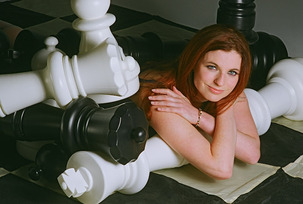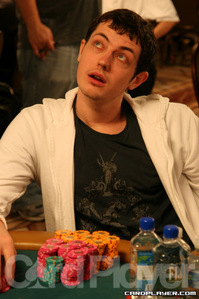






The Poker Player's Guide To Chess GamblingA Peek At The World Of High-Stakes Chess |
|
|

Jennifer Shahade
After winning the match easily, Greg was the envy of the chess world. He later called the experience “surreal, as I remember my younger days of playing anything from $2-$10 per game, and being extremely happy to win fifty dollars from playing chess.” Greg was the natural choice to freeroll off the intersection of chess and nosebleed prop-betting. A SuperNova on PokerStars, known as “curtains” online, Greg secured title sponsorship from PokerStars for his pet project, the U.S. Chess League. The USCL is a yearly team competition of the top grandmasters and champions from 16 of the strongest American chess cities.
As the U.S. Chess League enters its seventh year with PokerStars, a federal court in Brooklyn recently declared that poker is a skill game. The New York Times reported, “In a ruling that goes to the heart of what it means to play poker, Judge Jack B. Weinstein…[reasoned that] poker is more of a game of skill than a game of chance.” The decision compared poker to chess in several instances, and used 415 million PokerStars hands from April 2010 to March 2011 to prove that given a large enough sample, skill checkmates luck.
More and more poker players have been asking me about chess lately, how to improve, and how to reasonably gamble on the game. The chess world is structured around a ranking system (ELO) that leaves little room for error and is published next to a player’s name at every tournament, as if lifetime wins and losses were taped onto a poker player’s forehead. A chess player rarely agrees to play for serious money against a higher rated player. Indeed, the night before the WSOP main event, a poker pro rated about 2100 asked me (I’m 2322) to play a blitz match. The stakes he proposed? $5 a game — a full .05 percent of the tournament we’d be playing the next afternoon!

Tom Dwan lost $50,000 to Jennifer's brother Greg at the 2007 WSOP
But as durrrr, curtains and raptor illustrated so dramatically, just because it’s hard to gamble on chess, doesn’t mean we shouldn’t try. Welcome to the ultimate degenerate’s guide to chess:
1. Brother, Can You Spare a Bishop?
As in the Shahade-Dwan game, you can alter the number of pieces each player starts with to handicap a chess game. The pawn is used to scale the rest of the army and set at one point. The knight and bishop are three points each, the rook is five points and the queen is nine points. Piece odds are best used for extreme skill discrepancies like a beginner versus a seasoned tournament player.
2. Dude, Where’s My Clock?
Most chess players use a double-sided clock for every game — when you are thinking, your time dwindles down. After you make a move you hit a button that switches the ticking pressure to your opponent. If you run out of time, you lose the game. Time limits range from a casual “blitz” game, in which each side has five minutes or less to a match for the World Championship, when each player has hours.
Players can also start with different amounts of time, ideally tweaked so that a stronger player loses on time as often as he checkmates. At the 2011 WSOP, the aforementioned grandmaster Hikaru Nakamura and a strong chess amateur and poker pro, Brandon Alan Lee, agreed to play a high-stakes blitz match. Brandon would receive two and a half minutes a game to Hikaru’s 30 seconds. Hikaru told me he was optimistic about his chances, but neither of us had a chess set or clock.
So I tweeted, “Need chess board and clock ASAP for some high stakes #wsop #chess action involving world #6 @GMHikaru.” We soon got a reply that led us to the Amazon room, which led us to the Rio parking lot, which led us to a van stuffed to the roof with boxes and bags. The generous soul we interrupted deep in a pot-limit Omaha bracelet event had packed all his belongings in his van soon after Black Friday to save money while chasing a few more dreams at the WSOP. We searched for what felt like hours in the desert sun and amidst socks and VHS tapes, finally located the clock and set. Finding the clock turned out to be harder than the match. Hikaru won the first few games so convincingly that he gamely accepted a buy-out.

Jennifer with a chess roulette wheel. Credit: Betsy Dynako for the STL Chess Club
Combining chess with chance dates back to ancient precursors, in which the throw of a die determined which piece a player could move. I created a roulette chess wheel with curator and artist Larry List for a 2009 exhibition, “Chance Aesthetics” at the Kemper Art Museum in Saint Louis. The wheel incorporates graphics inspired by chess master and artist Marcel Duchamp. It is also a playable game. Before each move, you spin the wheel to determine which piece you can move — most spokes have two choices on them and the pieces are distributed to promote game flow. Like guessing whether a flop is red or black, the wheel can also be used for less skill-oriented side bets. My advice? Always bet on the bishop.
4. Heads-up Poker Chess
A pure way to combine chess and poker is a chess match with poker chips at stake on each game. For instance, we could play ten games of chess with 100 poker chips for the winner of each game. If I win the match 6-4, we’d go onto a heads-up poker match with me starting with 600 chips and you with 400. This system can be modified to include multiple players and to increase the weight of either poker or chess.
-276x176.jpg)
Jennifer plays Kenny Shei, with Terrence Chan looking on at 2012 WSOP. Credit: Rodney Chen
I ironed out the rules of Chinese poker chess at this year’s WSOP. The two games merge well. Both can easily be played head to head on a small table and it makes sense to reward players who set their Chinese hands quickly. The hybrid starts with two-player Chinese poker. Whoever sets her hand first hits the other player’s clock. The slower player must set his hands before he makes his first chess move, while his clock is ticking down. The game works best with super-fast time controls aka “bullet”, because otherwise it skews too heavily in favor of chess skill. I was usually slower than my opponents at Chinese, but better at chess.
So we’d play one minute games and as I thought an extra 20 to 30 seconds on my settings, I’d have to win the chess game in about 30 seconds. The chess game is worth three points; beating your opponent in Chinese is worth two points; sweeping Chinese is four. You get a bonus point for sweeping the Chinese AND winning the chess game.
I usually played this hybrid with Chinese low (five-card high hand in the back, five-card low hand in the middle and three-card high hand in the front) but it could be played with Chinese high, or even 17 (five-card high hand, five-card low hand, four-card Badugi hand and a three-card high hand.) We could even merge chess with the latest Open Face Chinese craze, but isn’t open-face enough like chess already?
Try one out yourself. Even without $50,000 at stake, you may find your brain straining in a way that reminds you of your favorite skill game.
Jennifer Shahade is a two-time U.S. Women’s chess champion, author and editor of uschess.org/clo. She writes for PokerStarsWomen, produces videos at pokerfairytale.com and YouTube.com/XChessChamps and is a member of the Grindettes. Find out more on jennifershahade.com and follow at twitter.com/jenshahade.
